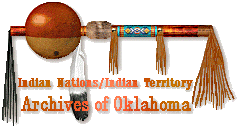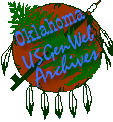|
Muskogee Sunday
Phoenix & Times Democrat
May 23, 1976
It was Russell Keck of Porter who first called to ask why Yonkers, in
Wagoner County, wasn't included along with the 22 Muskogee area "ghost
towns" listed here May 9.
Truthfully, we forgot about Yonkers when it was not listed among the
683 "ghost towns" in Oklahoma shown on the Historical Map of Oklahoma,
to be found in many book stores and gift shops throughout the state.
Yet Yonkers for years was a thriving community, serving a large farming
area on the east side of Grand River, north and east of
Wagoner. It was reached from Wagoner by a ferry across Grand
River or from Locust Grove or Tahlequah by a torturous wagon road.
Yonkers was named by William Kenefic, railroad developer, for Yonkers,
New York, when the Kansas, Oklahoma & Gulf Railroad reached
that area in 1912. Today the site of the town is under water
impounded by the Fort Gibson Dam to create Fort Gibson Lake.
During its history the Yonkers area has been located in two
counties. It was included in Cherokee County when the State
of Oklahoma was organized, but in 1923 became part of Wagoner County.
The "official" reason for the election to leave Cherokee County and
annex to Wagoner County was that it was more convenient for residents
to reach Wagoner and conduct court house business.
Unofficially, old-time area residents say, Coweta was threatening an
election to move the Wagoner County Court House, and Wagoner needed the
extra votes in the Yonkers area to assure retaining the county seat.
An added inducement for joining Wagonoer County, it is said, was a
promise of Wagoner County Commissioners to build a bridge across Grand
River if the annexation was voted.
The change was bitterly contested, and "there were a lot of black eyes
and hangovers the day after the election," one old-timer
reports.
No bridge was ever built.
Yonkers was a post office from January 31, 1913, to September 30, 1935.
Joe Young, now living in Wagoner, was one of the Yonkers
postmasters. He also operated a grist mill, equipped with
French burhrs, and a store in Yonkers for years.
In addition to the grist mill, Yonkers at one time had two stores and a
blacksmith ship. Dick Holland, the blacksmith, still has a
shop in the Yonkers area.
It also had a school. Mrs. Bessie Cannon, now
living north of Wagoner on U.S. 69, was the first school teacher, in
what was then a log school house, in Territorial days.
Mrs. Cannon, now 86 years old, married her husband, also named Bessie,
in 1915. The couple bought their first land in the Yonkers
area in 1918, and when forced to sell because of lake condemnation had
900 acres of bottom land along Grand River.
Mrs. Earl (Mabel Ketcher)Smith of Wagoner was also a former teacher at
Yonkers, although the log school had been replaced with a frame
structure by the time she taught there. She also taught at
Rock School in Hell's Bend, just across the river, in 1923 and 1924.
In the one-room school at Yonkers, Mrs. Smith taught the entire eight
grades. Usually there were 30 to 40 pupils at the school, but
enrolment at times was between 50 and 60.
Because of the heavy Cherokee Indian population in the Yonkers area,
Mrs. Smith always had some full-blood Cherokee children
enroled. Requently, she says, the children would come to
school unable to speak anything but Cherokee.
"But give them a few weeks listening to and watching other pupils and
they could do their school work right along with the others,"
Mrs. Smith says.
There never was a discipline problem in her schools, Mrs. Smith
emphasizes. "There was never a time when the county
superintendent, board members or parents came to the school that
couldn't hear a pin drop," she says.
One reason for such discipline, Mrs. Smith insists, is that "I had the
backing of all parents 100 per cent."
*****************************
** NOTE from Shellie Merrell**
Joe Young was my great, great
uncle. My father, Raymond Leon Merrell, went to Yonkers rock
school in kindergarten, and then the family had to move because the
town was going to be flooded by the new dam's completion.
Still to this day, there is a tree that still holds the wire to my
Daddy's swing only yards away from the Yonkers school. Daddy
was so happy to still see it in the tree. The only thing left
of Joe Young's store is a massive slab of rock that was a part of the
steps into the store. The brick well of the station master's
house is still there and a few remaining house foundations are all
that's left of the town. Every spring the town gets flooded
when the corps raises the lake levels.
|








